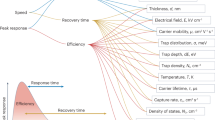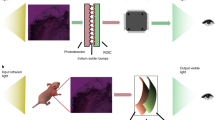Abstract
Among the various applications for reversible holographic storage media1,2, a particularly interesting one is time-gated holographic imaging (TGHI)3,4,5. This technique could provide a noninvasive medical diagnosis tool, related to optical coherence tomography6,7. In this technique, biological samples are illuminated within their transparency window with near-infrared light, and information about subsurface features is obtained by a detection method that distinguishes between reflected photons originating from a certain depth and those scattered from various depths. Such an application requires reversible holographic storage media with very high sensitivity in the near-infrared. Photorefractive materials, in particular certain amorphous organic systems, are in principle promising candidate media, but their sensitivity has so far been too low, mainly owing to their long response times in the near-infrared. Here we introduce an organic photorefractive material—a composite based on the poly(arylene vinylene) copolymer TPD-PPV8—that exhibits favourable near-infrared characteristics. We show that pre-illumination of this material at a shorter wavelength before holographic recording improves the response time by a factor of 40. This process was found to be reversible. We demonstrate multiple holographic recording with this technique at video rate under practical conditions.
This is a preview of subscription content, access via your institution
Access options
Subscribe to this journal
Receive 51 print issues and online access
$199.00 per year
only $3.90 per issue
Buy this article
- Purchase on Springer Link
- Instant access to full article PDF
Prices may be subject to local taxes which are calculated during checkout



Similar content being viewed by others
References
Burr, G. W. & Leyva, I. Multiplexed phase-conjugate holographic data storage with a buffer hologram. Opt. Lett. 25, 499–501 (2000)
Stepanov, S. in Handbook of Advanced Electronic and Photonic Materials and Devices Ch. 6 (ed. Nalva, H. S.) Vol. 2 (Academic, New York, 2001)
Hyde, S. C. W. et al. Depth-resolved holographic imaging through scattering media by photorefraction. Opt. Lett. 20, 1331–1334 (1995)
Jones, R. et al. Holographic storage and high background imaging using photorefractive multiple quantum wells. Appl. Phys. Lett. 69, 1837–1839 (1996)
Steele, D. D. et al. Transillumination imaging through scattering media by use of photorefractive polymers. Opt. Lett. 23, 153–155 (1998)
Huang, D. et al. Optical coherence tomography. Science 254, 1178–1181 (1991)
Drexler, W. et al. In vivo ultrahigh-resolution optical coherence tomography. Opt. Lett. 24, 1221–1123 (1999)
Hörhold, H. H. et al. Synthesis of TPD-containing polymers for use as light-emitting materials in electroluminescent and laser devices. Proc. SPIE 4105, 431–442 (2001)
Moerner, W. E., Grunnet-Jepsen, A. & Thompson, C. L. Photorefractive polymers. Annu. Rev. Mater. Sci. 27, 585–623 (1997)
Zilker, S. Materials design and physics of organic photorefractive systems. ChemPhysChem 1, 72–87 (2000)
Kukhtarev, N. V., Markov, V. B., Odulov, S. G., Soskin, M. S. & Vinetskii, V. L. Holographic storage in electrooptic crystals. I. Steady state. Ferroelectrics 22, 949–960 (1979)
Moerner, W. E., Silence, S. M., Hache, F. & Bjorklund, G. C. Orientationally enhanced photorefractive effect in polymers. J. Opt. Soc. Am. 11, 320–330 (1994)
Wortmann, R. et al. Design of optimized photorefractive polymers: A novel class of chromophores. J. Chem. Phys. 105, 10637–10647 (1996)
Ashley, J. et al. Holographic data storage. IBM J. Res. Dev. 44, 341–367 (2000)
Würthner, F., Wortmann, R. & Meerholz, K. Chromophore design for photorefractive organic materials. ChemPhysChem 3, 17–31 (2002)
Silence, S. M., Bjorklund, G. C. & Moerner, W. E. Optical trap activation in a photorefractive polymer. Opt. Lett. 19, 1822–1824 (1994)
Herlocker, J. A. et al. Stabilization of the response time in photorefractive polymers. Appl. Phys. Lett. 77, 2292–2294 (2000)
Wolff, J., Schloter, S., Hofmann, U., Haarer, D. & Zilker, S. Speed enhancement of photorefractive polymers by means of light-induced filling of trapping states. J. Opt. Soc. Am. B 16, 1080–1086 (1999)
Buse, K., Adibi, A. & Psaltis, D. Non-volatile holographic storage in doubly doped lithium niobate crystals. Nature 393, 665–668 (1998)
Günther, H., Macfarlane, R., Furukawa, Y., Kitamura, K. & Neurgaonkar, R. Two-color holography in reduced near-stoichiometric lithium niobate. Appl. Opt. 73, 7611–7623 (1998)
Grunnet-Jepsen, A. Spectroscopic determination of trap density in C60-sensitized photorefractive polymers. Chem. Phys. Lett. 291, 553–561 (1998)
Wang, L., Ng, M.-K. & Yu, L. Photorefraction and complementary grating competition in bipolar transport molecular material. Phys. Rev. B. 62, 4973–4984 (2000)
Zilker, S. J. & Hofmann, U. Organic photorefractive glass with infrared sensitivity and fast response. Appl. Opt. 39, 2287–2290 (2000)
Wang, L., Ng, M. K. & Yu, L. Efficient molecular photorefractive materials based on methine dyes. Appl. Phys. Lett. 78, 700–702 (2001)
Steenwinckel, D. V., Hendrickx, E., Persoons, A., Van den Broeck, K. & Samyn, C. Influence of the chromophore ionization potential on speed and magnitude of photorefractive effects in poly-N-vinylcarbazole based polymer composites. J. Chem. Phys. 112, 11030–11037 (2000)
Kippelen, B. et al. Infrared photorefractive polymers and their applications for imaging. Science 279, 54–57 (1998)
Boppart, S. A. et al. In vivo cellular optical coherence tomography imaging. Nature Med. 4, 861–865 (1998)
Hummelen, J. C. et al. Preparation and characterization of fulleroid and methanofullerene derivatives. J. Org. Chem. 60, 532–538 (1995)
Acknowledgements
We thank R. Bittner, D. Müller, M. Hofmann and R. Birngruber for discussions. Financial support was granted by the Volkswagen Foundation (Germany), the European Space Agency (MAP-project), the Fonds der Chemischen Industrie (Germany), and the Bavarian government through ‘Neue Werkstoffe’ (Germany).
Author information
Authors and Affiliations
Corresponding author
Ethics declarations
Competing interests
The authors declare that they have no competing financial interests.
Rights and permissions
About this article
Cite this article
Mecher, E., Gallego-Gómez, F., Tillmann, H. et al. Near-infrared sensitivity enhancement of photorefractive polymer composites by pre-illumination. Nature 418, 959–964 (2002). https://doi.org/10.1038/nature00975
Received:
Accepted:
Issue Date:
DOI: https://doi.org/10.1038/nature00975
This article is cited by
-
Molecular design of photorefractive polymers
Polymer Journal (2016)
-
A real-time dynamic holographic material using a fast photochromic molecule
Scientific Reports (2012)
-
High-performance photorefractive polymer composites doped with 2-piperidino-5-thienylmalononitrile chromophore
Macromolecular Research (2010)
-
Multiple-scattering speckle in holographic optical coherence imaging
Applied Physics B (2009)
-
Femtosecond properties of photorefractive polymers
Applied Physics B (2009)
Comments
By submitting a comment you agree to abide by our Terms and Community Guidelines. If you find something abusive or that does not comply with our terms or guidelines please flag it as inappropriate.



